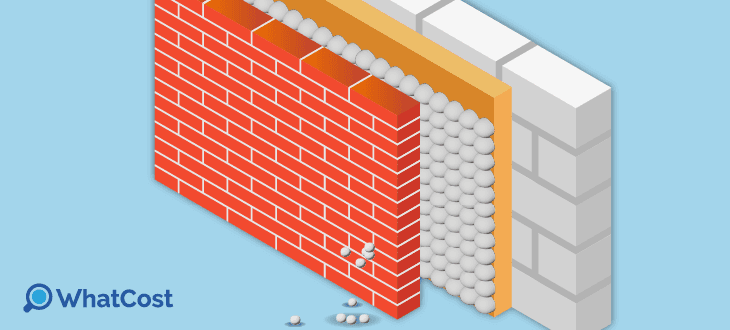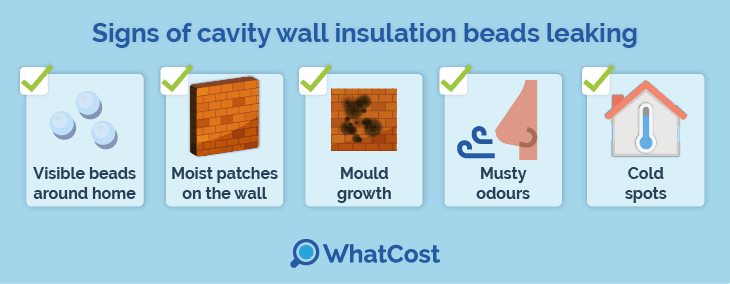Answer these simple questions and we will find you the BEST prices
Which type of solar quotes do you need?
It only takes 30 seconds
100% free with no obligation

Tell us what you need to find a matching specialist

Get free quotes from professionals near you

Compare offers and choose the one that best matches your need
- whatcost.co.uk
- Home Insulation
- Wall Insulation
- Cavity Wall Insulation
- Bead Cavity Wall Problems
Does Bead Cavity Wall Insulation Cause Problems?

- About 25% of cavity wall homes in the UK remain uninsulated, which can result in high energy bills.
- Cavity wall insulation can save you up to £405 annually on your energy bills, depending on your property type.
- If not properly installed by a professional, bead cavity wall insulation can cause problems such as moisture, structural damage, and thermal bridging.
Approximately 14.8 million homes in the UK currently have cavity wall insulation, with 71% of homes featuring cavity walls. Despite the increasing adoption of this energy-saving measure, a surprising 25% of UK homes with cavity walls remain uninsulated, highlighting a significant opportunity for improvement.
Cavity wall insulation offers considerable benefits, including reduced energy bills, improved energy efficiency, and a lower carbon footprint. One of the most popular options for insulation is bonded bead insulation, known for its effectiveness and ease of installation. However, cavity wall insulation polystyrene bead problems and other bead cavity wall insulation problems can arise, making it essential to understand the potential challenges before proceeding.
To help you make an informed decision, this WhatCost guide explores the common issues associated with polystyrene bead insulation, practical solutions to address them, and the key advantages that make it a popular choice among homeowners.
Are you ready to insulate your cavity walls or interested in knowing how to check for cavity wall insulation? Finding the right insulation specialist is crucial. Fortunately, WhatCost can simplify this process for you. By filling out our quick 30-second form, we can provide up to four free quotes from the best insulation specialists in your area. Click below to learn more.
- Describe your needs
- Get free quotes
- Choose the best offer
It only takes 30 seconds



What problems can occur with polystyrene bead cavity wall insulation?
Polystyrene bead cavity wall insulation installation is gaining popularity among homeowners due to its ease of installation, excellent thermal performance, and ability to reduce a household’s carbon footprint. However, it’s important to be aware of potential cavity wall insulation polystyrene beads problems that could occur. Below are some of the common issues you should consider:
Moisture and dampness
Polystyrene beads can become wet as a result of poor ventilation or if the walls are not prepared correctly. This can lead to cavity wall insulation damp patches on your internal walls which can contribute to the growth of mould and mildew.
However with professional installation these issues can be prevented as they will thoroughly inspect your cavity and internal walls to identify and resolve any pre-existing dampness or cracks in the walls before adding insulation. Proper sealing of the cavity is essential to prevent water ingress.
Structural damage
Polystyrene beads are lightweight and require the structural integrity of the cavity walls to be intact. In older properties or poorly maintained walls, introducing insulation can exacerbate existing cracks, gaps, or structural weaknesses, potentially leading to further deterioration.
To avoid structural damage use a qualified professional to inspect the condition of your walls. Repairs should be made to any damaged areas, and alternative insulation methods may be recommended if the walls cannot support the beads.
Over-bonding beads
Overbonding occurs when too much adhesive is used during the installation of polystyrene beads. This can lead to clogged cavities or restricted airflow, which reduces the insulation’s effectiveness and may contribute to moisture buildup. By using professional installers, you can be assured that the correct level of bonding agent is applied.
Under bonding beads
Underbonding occurs when insufficient adhesive is applied to the polystyrene beads, causing them to settle, shift, or fall out of place. This can result in uneven insulation coverage and the formation of thermal bridges. Certified professionals carefully measure and apply the right amount of adhesive to ensure the beads stay securely in place and maintain their insulating properties.
Bead leakage

Bead leakage occurs when polystyrene beads escape through gaps, cracks, or poorly sealed areas in the cavity walls. This issue is often a result of improper sealing during installation or deteriorated wall structures in older homes. To avoid this, it is essential to inspect the walls for cracks and gaps beforehand and ensure all openings are sealed effectively to prevent leakage.
Thermal bridging
Poor installation of the polystyrene beads may result in the insulation not covering the entire cavity which can result in cold spots. Additionally, the polystyrene beads can shift or settle unevenly within the cavity, especially if the installation was rushed or if there are irregularities in the cavity walls. This can lead to thermal bridges, where areas of the wall are less insulated.
To avoid thermal bridging, it is important to use experienced installers to ensure even distribution of the beads and proper installation techniques to minimise the risk of settlement. High-quality bonding agents can also help keep the beads in place.
Difficult removal
Polystyrene beads are small and lightweight, making them challenging to remove if insulation needs to be replaced due to wall damage or remodeling. This difficulty is exacerbated when beads have bonded to parts of the wall. Professionals can install the insulation in a way that minimises future removal challenges by using appropriate techniques and adhesives, though removal is inherently a complex process.
Signs of cavity wall insulation beads leaking

If you suspect your cavity wall insulation beads are leaking, there are some clear signs to look out for. Polystyrene beads are lightweight and small, making leaks noticeable in certain conditions. If left unchecked, leaking insulation can reduce its effectiveness, cause a mess, and even lead to further issues with your property.
Here’s how to identify if your cavity wall insulation beads are leaking:
- Visible beads around your home: Loose polystyrene beads found near vents, skirting boards, or windows often indicate insulation bead leakage due to gaps or cracks in your cavity walls.
- Moist patches on internal walls: Damp patches on internal walls can signal moisture buildup in the cavity, often caused by cracks in external walls or leaking insulation beads.
- Mould growth: An increase in mould growth may indicate moisture issues from leaking insulation. This can lead to voids or persistent damp conditions in the cavity.
- Musty odours: A musty smell in your home could suggest trapped moisture or mould in your walls, often due to leaking insulation beads or insufficient sealing.
- Drafts or cold spots: Leaking beads create voids in the cavity, leading to drafts or cold spots, which reduces the insulation's effectiveness and makes your home feel colder.
Cavity wall insulation bead leakage can occur due to improper installation, aging properties, cracks in external walls, or weather-related damage. Addressing these issues promptly is crucial to avoid expensive repairs and maintain the effectiveness of your insulation.
How to prevent problems with bead cavity wall insulation
Bead cavity wall insulation is an efficient and popular method of enhancing energy efficiency and reducing heating costs. However, issues like cavity wall insulation beads escaping and other common problems can arise if proper precautions are not taken.
Following best practices and working with experienced professionals can prevent these problems and ensure the insulation performs effectively for years. Whether it is cavity wall insulation for a new build or renovation here are ways to prevent these problems:
- Inspect and repair external walls: Before installing bead cavity wall insulation, it's essential to inspect the condition of your external walls. This includes sealing gaps, weatherproofing your external walls, and sufficient ventilation to prevent condensation.
- Use high-quality materials: Invest in high-quality polystyrene beads and adhesive to reduce the likelihood of issues such as settlement, moisture penetration, or beads escaping. Substandard materials can degrade over time or fail to bond properly, leading to bead cavity wall insulation problems.
- Remove existing insulation: If you’re upgrading your cavity wall insulation, it’s crucial to remove the old insulation before installing new cavity wall insulation beads. While this process can be expensive, insulation grants in the UK can help cover the costs for qualifying households, making the upgrade more affordable.
- Work with a professional: Work with certified professionals to ensure proper installation. They will use the correct adhesive to prevent cavity wall insulation beads escaping due to underbonding or overbonding, assess walls for cracks or dampness, and evenly distribute beads to avoid voids, thermal bridging, and settlement.
Choosing the perfect specialist for your cavity wall insulation is key, yet comparing various quotes can be tedious and overwhelming. That's where WhatCost steps in. Complete our quick 30-second form to receive up to four free quotes from top-rated professionals in your area, with zero hidden fees and no obligation. Don't let time slip away—click below to learn more!
- Describe your needs
- Get free quotes
- Choose the best offer
It only takes 30 seconds



How to overcome problems with cavity wall insulation beads
Cavity wall insulation using polystyrene beads can be effective for improving energy efficiency, but issues may arise over time. Below are common problems and solutions to overcome them:
- Water penetration: Repair cracks in brickwork and use weatherproof sealants around windows, doors, and vents.
- Bead movement: Have a professional reinject beads where needed or use adhesive-coated beads to prevent shifting.
- Thermal bridging: Conduct thermal imaging to identify gaps and ensure professional installation for even bead distribution.
- Debris in the cavity: Inspect and clear debris before installation.
- Condensation issues: Improve ventilation and install vapour barriers to reduce moisture in the cavity..
By addressing these cavity wall insulation polystyrene beads problems, homeowners can maximise energy efficiency while preventing common pitfalls. Always consult professionals for installation or remediation to ensure long-term performance.
Is bead cavity wall insulation worth it?
Bead cavity wall insulation is an effective solution for improving energy efficiency and reducing heating costs when installed professionally and correctly. While it has significant benefits, it’s also worth considering cavity wall insulation alternatives to determine the best option for your home.
- Lower energy bills: Polystyrene beads effectively fill cavity spaces, minimising gaps and preventing heat loss. As a result, your energy bills could be reduced by up to £405 annually depending on your property type.
- Durability: When installed correctly, bead insulation can last for decades—often up to 100 years, without needing replacement. This means you won't have to continually replace your insulation, helping to keep future costs down.
- Even distribution: Beads can reach all areas of the cavity, ensuring consistent insulation throughout the wall.
- Quick installation: On average, cavity wall bead insulation installation takes about 1 to 2 hours, making it one of the fastest and least invasive methods available. Additionally, a quicker installation process can lower labour costs.
Cavity wall insulation beads offer a host of advantages that clearly outweigh any downsides. Partnering with a professional installer is essential for optimal performance and peace of mind. Yet, finding a qualified installer at a competitive price can feel overwhelming. Researching options and making countless phone calls can waste precious time without guaranteeing the best deal.
That’s where WhatCost steps in to make your life easier. By filling out our 30-second form, we can provide up to four free customised quotes. Click below to take the first step toward a warmer, more energy-efficient home!
- Describe your needs
- Get free quotes
- Choose the best offer
It only takes 30 seconds



FAQ
Bead cavity wall insulation itself does not cause damp, but improper installation, pre-existing wall damage, or poor maintenance can lead to moisture issues if not addressed beforehand.
Yes, polystyrene beads are excellent for insulation due to their high thermal efficiency, moisture resistance, and ability to fill cavity spaces evenly.
The bad type of cavity wall insulation is one that is poorly suited to your property, such as materials prone to moisture retention or improperly installed insulation that can lead to damp, mould, or structural issues.

Caoimhe is an experienced content writer and researcher who is passionate about providing accessible information to every reader. With a background in English literature and Sociology, she combines the two disciplines to create cohesive, well-thought-out, and well-informed pieces.
- Does Bead Cavity Wall Insulation Cause Problems?
- What problems can occur with polystyrene bead cavity wall insulation?
- Signs of cavity wall insulation beads leaking
- How to prevent problems with bead cavity wall insulation
- How to overcome problems with cavity wall insulation beads
- Is bead cavity wall insulation worth it?
- FAQ
- Describe your needs
- Get free quotes
- Choose the best offer
It only takes 30 seconds



